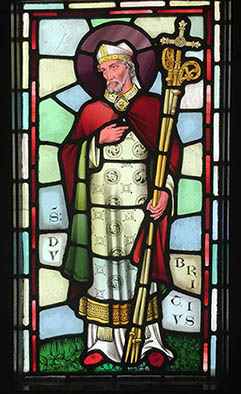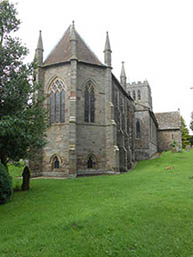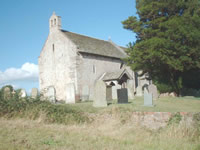
Window at Castell Coch
Dubricius is the Latin form of the Welsh name Dyfrig. This saint is only known from sources half a millennium later than the time he is suppose to have lived, which makes any account of his life a little uncertain.
According to these sources Dyfrig was the illegitimate son of Ebrdil, the daughter of King Peibio Clafrog of Ergyng. His grandfather threw his mother into the River Wye when he discovered she was pregnant, but she was miraculously saved from drowning. Dyfrig was born in the village of Madley, Herefordshire. He and his mother were reconciled with Peibio when the child's touch cured the king of leprosy.
Dyfrig - the Latin form is Dubricius - was revered as the evangelist and first Bishop of Egyng, a diocese which ultimately gave birth to that of Llandaff. It probably would would have surprised Dyfrig had he known that one day his diocese would be in the charge of Bishop June Osborne, who was installed as the 72nd Bishop of Llandaff on 22 July 2017. Mary Stallard succeeded Bishop Osborne in 2023.
The Anglo-Saxon Chronicle records that in 915 Cyfeiliog, the bishop of Archenfield, the English name for Erging, was captured by the Danish earls Ohter and Rhoald, coming from the River Severn. The bishop was ransomed for forty pounds by King Edward the Elder.
Dubricius is not a common dedication. Four other churches in Herefordshire are dedicated to the saint - Ballingham, St Devereux, Whitchurch, and Hamnish. There is a Church of St Dubricius at Gwenddwr in Breconshire (probably not an old dedication) and at Llanvaches in Newport, Monmouthshire. There is also a church dedicated to him at Porlock in Somerset, and a Roman Catholic Church at Treforest.
Although Dyfrig is often considered to be the evangelist of south-east Wales, of which Ergyng formed part, It is entirely possible that at the time there was still an active Christian Church in the area, originating in the late Roman Empire, when Christianity became the major Roman religion, and that Dyrig's whole life was spent within an entirely Christian milieu. In Ergyng, a bishopric seems to have been based at St Constantine's Church at Garthbenni (a different Hentland, in Goodrich parish) by about 500AD.

Madley Church
Dyfrig's life is legendary rather than historical, although the man certainly was real. The story in the Book of Llandaff relating that Dyfrig was the illegitimate son of a king's daughter, Ebrdil, is a typical hagiographic device. The tale may echo reflects an earlier story in which Ebrdil is an earlier (male) saint whose spiritual inheritance passed to Dyfrig. The church at Madley, Herefordshire, where, according to legend, Dyfrig was born, seems to have had an early dedication to St Ebrdil - Lann Ebrdil. Madley may have been a prehistoric religious site which became associated with the premier local saint.
Whatever Madley's original sacred nature may have been, the association with Dyfrig's mother probably led to its subsequent strong cult of Mary, the mother of Christ. The rebuilding of what had been a 12th century aisleless church was carried out in the 13th century in response to a pilgrim interest in a figure of the Virgin there. Any pilgrim activity at Madley is likely to have been developed as a spin-off from the cult of St Ethelbert at Hereford. A now-missing north chancel window was described by Thomas Blount in about 1675 - 'In the North Window we see a Picture of St Ethelbert holding a Church in his hand, and a Queen standing by Him, with the Arms of England - in another window a crosse and by it the effigies of a Woman under whom it is written 'Sta. Mildburga pray for the (blank)' and for the souls of all Christians'. The figure might have been St Mildburg, and the statue that of the Virgin Mary, but the likelihood is that an earlier cult was being remembered here - that of Ebrdil and her son Dyfrig, in the premier church of the land once named after her, Ynys Ebrdil - the Isle of Ebrdil. The Welsh word ynys may not always apply to an island in the normal English sense and is often used for a distinct parcel of land which is only partially, or not at all, bounded by water.

The church at Moccas
Dyfrig founded a large monastery at Llanfrother in what is now Hentland parish, where he stayed for seven years, before founding another monastery at Moccas, 47km upstream.
Among Dyfrig's followers were the British (Welsh) saints Teilo and Samson, and he is also supposed to have cured the sick of South East Wales. The Book of LLandaff records Dyfrig as the Bishop of Ergyng, which, with Glamorgan and Gwent, became the diocese of Llandaff.
Dyfrig was followed sequentially by first, St Teilo, then St Oudoceus as territorial bishops presiding over a diocese in the standard contemporary Roman fashion. Such territorial diocese may have not only continued, but expanded, in the immediate post-Roman period.
Dyfrig was an associate of Saints Illtud and Samson. He retired to Bardsey Island where he was buried. Bardsey Island Ynys Enlli is known as the 'Island of 20,000 Saints' lies 3 km off the Llyn Peninsula in Gwynedd.
In 1120 Dyfrig's body was transferred to Llandaff Cathedral by Bishop Urban.
In the 11th century there was another Herefordshire church, Llanwarne, dedicated to Teliau and Dyfrig:'Lann Guern Teliau ha Dubric'.